MOF Structure Finally Wins Nobel Prize After 36 Years: When AI Understands Chemistry, metal-organic Frameworks Are Moving Towards the Era of Generative Research

On October 8, 2025, the Nobel Prize in Chemistry was announced in Sweden.The Royal Swedish Academy of Sciences has decided to award the 2025 Nobel Prize in Chemistry to Professor Susumu Kitagawa of Kyoto University, Professor Richard Robson of the University of Melbourne, and Professor Omar Yaghi of the University of California, Berkeley, in recognition of their research contributions in the field of "Metal-Organic Frameworks" (MOF).This research field, which has been validated by the market for more than 30 years, has now become an annual footnote in world science.
"The novel molecular structure created by Susumu Kitagawa, Richard Robson and Omar Yaghi contains a large cavity that allows molecules to pass through, thus harvesting moisture from desert air, extracting pollutants from water, or capturing carbon dioxide and storing hydrogen," said Heiner Linke, chairman of the Nobel Prize Committee for Chemistry, in the official Nobel Prize news release.Metal-organic frameworks (MOFs) hold enormous potential and may bring previously unforeseen opportunities for tailoring materials with new functionalities.
Beyond the Nobel Prize, the significance of MOFs extends beyond materials science itself, ushering in an era in which humanity reinterprets the material world. With the discovery of programmable three-dimensional space at the molecular scale, chemistry has gradually moved from discovery to design, transitioning to the logic of data, algorithms, and AI.
More AI frontier papers:
https://hyper.ai/papers
From coordination polymers to MOFs: 36 years of chemical puzzles
In fact, from the 1980s to 2025, the Nobel Prize winnersThe research on MOFs has witnessed a three-stage evolution from chemical concept exploration to systematic design.
In 1989, Richard Robson first proposed the structural concept of three-dimensional coordination polymers.He attempted to exploit the inherent properties of atoms in a new way. He used coordination bonds to connect metal nodes with organic ligands into a periodic network structure. He combined positively charged copper ions with a four-armed molecule, creating a molecule in which each arm ended in a chemical group that attracted the copper ion. "When they joined together, they condensed into a crystal with an orderly, vast expanse, like a diamond filled with countless voids."
This research, titled "Infinite Polymeric Frameworks Consisting of Three Dimensionally Linked Rod-like Segments," was published in the Journal of the American Chemical Society (JACS). Ben F. Hoskins, one of Robson's early co-authors, co-authored this groundbreaking paper, providing the first experimental evidence for the concept of MOFs.
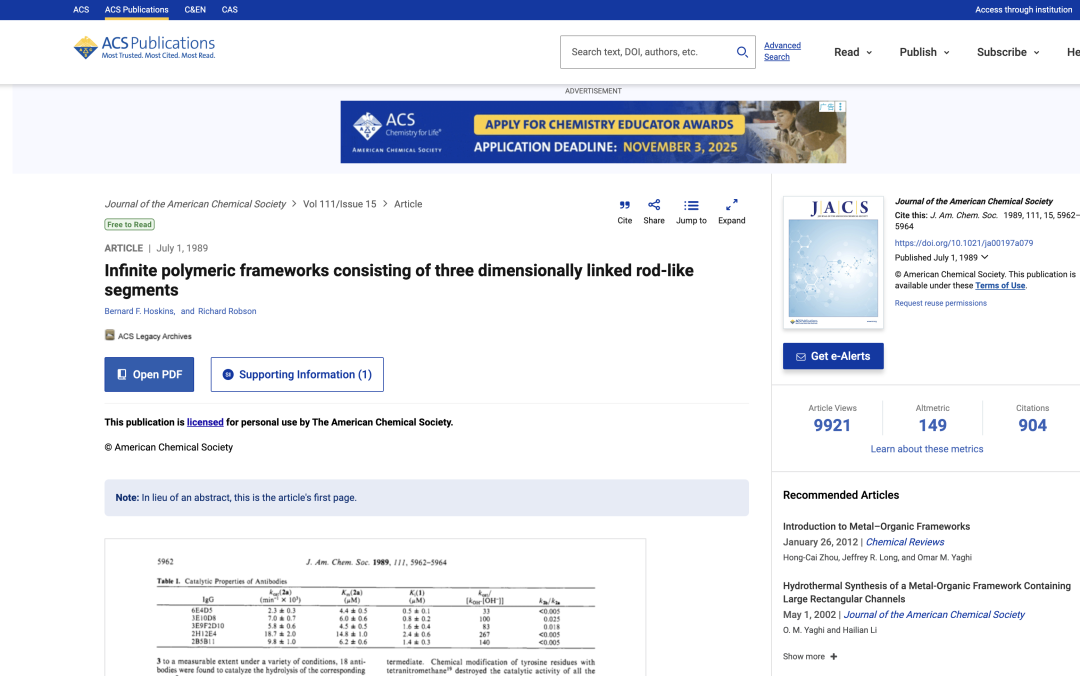
In the following 15 years, Omar Yaghi and Kitagawa Susumu's team published many papers in journals such as Nature and Science.Continuously achieved revolutionary breakthroughs in structural construction and functional regulation,With the establishment of MOF, a new porous material system, this research field has gradually taken shape and entered the stage of system expansion.
During this period, the academic community began to conduct grafting and other treatments on the MOF basic structure. Kitagawa Susumu proved that gases can flow into and out of this molecular structure, and proposed the concepts of "flexible frameworks" and "adjustable pores (Breathing MOFs)".It transforms MOF from a rigid pore material to a dynamic structural material, laying the foundation for the transformation of MOF from a rigid material to an intelligent response material.
In 1999, Omar Yaghi, known as the "Father of MOF", created a very stable MOF (MOF-5) and proved that it could be modified through rational design to give it new properties. As a representative metal-organic framework material, MOF-5 has been widely used in early research on hydrogen storage, gas adsorption, etc.His proposed concept of "reticular chemistry" propelled chemical synthesis into an era of structural predictability. Building on this, Mohamed Eddaoudi concurrently published papers such as "Metal-Organic Frameworks from Design Strategies to Applications," advancing the experimental and synthetic chemistry of early high-surface-area MOFs such as MOF-5.
During this period, Michael O'Keeffe also collaborated with Omar Yaghi to publish a research paper "Towards a Taxonomy of MOF Structures", which systematically described the underlying structure of crystals and MOFs from a topological perspective.
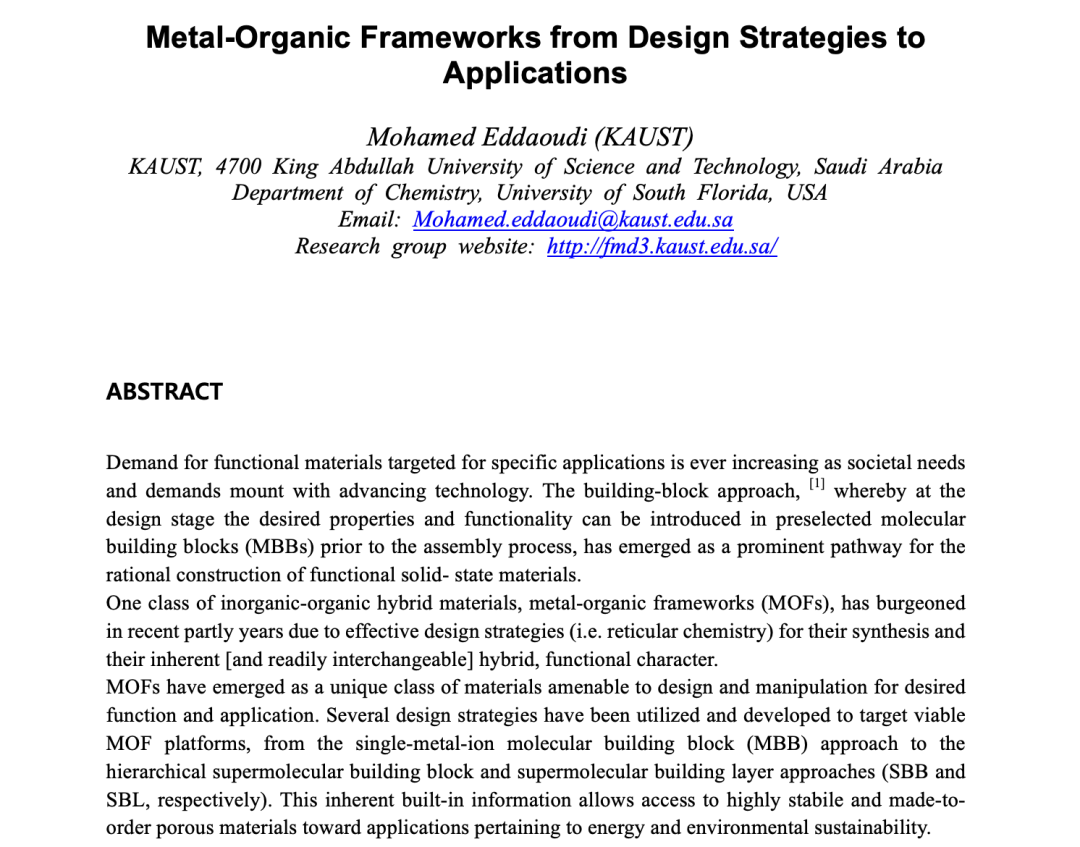
As MOF ushered in a research boom, it became the core research object in the fields of gas storage, drug delivery, catalysis, sensing, etc.MOF materials have entered the stage of industrialization and have shown application potential in fields such as gas storage, carbon capture and biomedicine.A variety of highly stable mainstream commercial MOF structures have begun to be industrialized, such as the Zr-based UiO series developed by Kitagawa Susumu's team in collaboration with Uppsala University in Sweden, which has become a commercially available high-thermal-stable MOF.
Since 2022, Atomis Co., Ltd., where Susumu Kitagawa serves as a scientific advisor, has been working with Yachiyo Engineering Co., Ltd. to develop a new energy gas distribution system called "Smart Gas Network" based on MOF technology.It is hoped that the MOF molecular structure can be used to adsorb and release difficult-to-control methane gases such as biogas and natural gas at the nanoscale at room temperature, without relying on pipeline infrastructure, thereby achieving lightweight gas transportation.
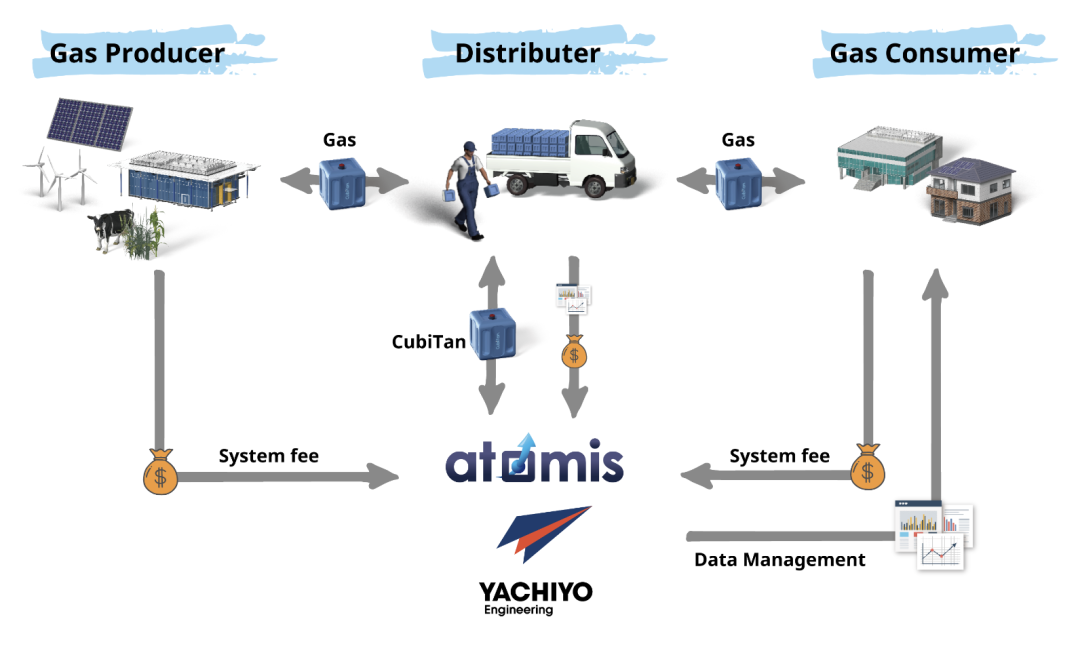
In the past 10 years, MOFs have been widely used in industrial carbon capture. For example, George Shimizu's research group at the University of Calgary developed a MOF material called CALF-20. In a paper published in Science, the research group mentioned that CALF-20 can maintain its performance under water, oxidizing, and exhaust gas conditions, unlike many previous MOFs that are easily deactivated in humid environments.CALF-20 is being used by Canadian company Svante to capture carbon dioxide and remove greenhouse gases from cement production exhaust. Furthermore, the electronics industry has also begun using MOF materials to absorb some of the toxic gases in the semiconductor production process.
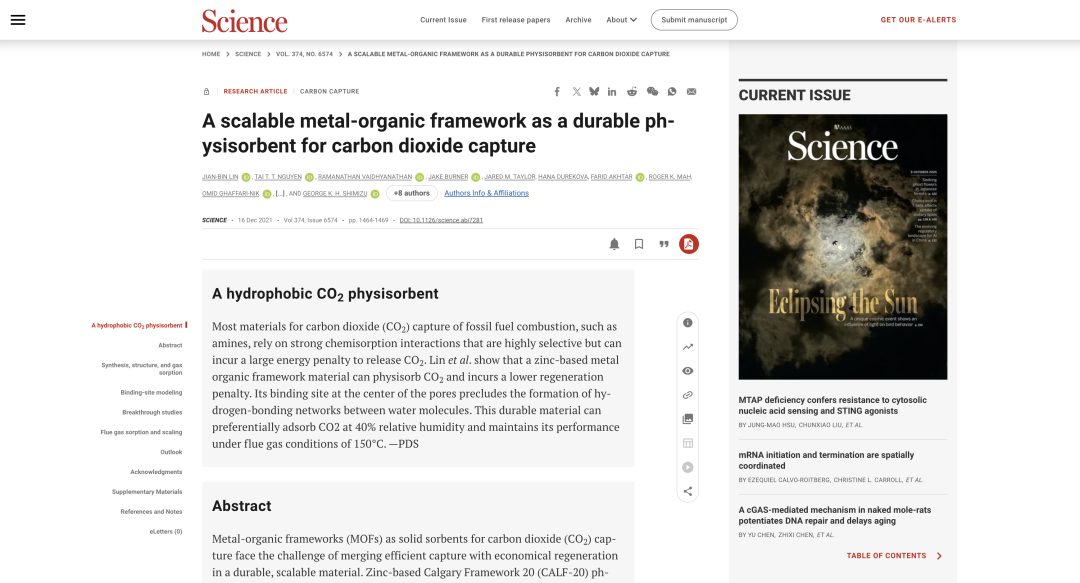
Regarding the special properties of MOF materials, Heiner Linke, chairman of the Nobel Committee and a nanophysicist at Lund University in Sweden, humorously said, "This material is almost like Hermione's handbag in Harry Potter." The Nobel Prize officials also stated in the official report that following the breakthrough discoveries of the three winners, the tens of thousands of different MOFs constructed by chemists may help solve some major challenges facing mankind.
Currently, according to a July 2025 survey by Science, MOFs have become the subject of more than 100,000 academic papers worldwide.
When MOFs are understood by algorithms: Chemistry and AI resonate
As artificial intelligence (AI) converges across various fields, many researchers are exploring the potential of "AI + MOFs." Previously, You Zhipeng's team at Nanchang University published a paper titled "Artificial Intelligence in Metal–Organic Frameworks from 2013 to 2024: A Bibliometric Analysis." Using bibliometric methods and knowledge graph visualization software, they analyzed research papers on MOFs AI from 2013 to mid-2024 in the Web of Science database.From the fitting curve, we can see that researchers are increasingly interested in the field of artificial intelligence in MOFs. Since 2016, the research on "AI + MOF" has experienced explosive growth.The number of literature continues to increase, showing that this cross-disciplinary direction has promising prospects worthy of attention.
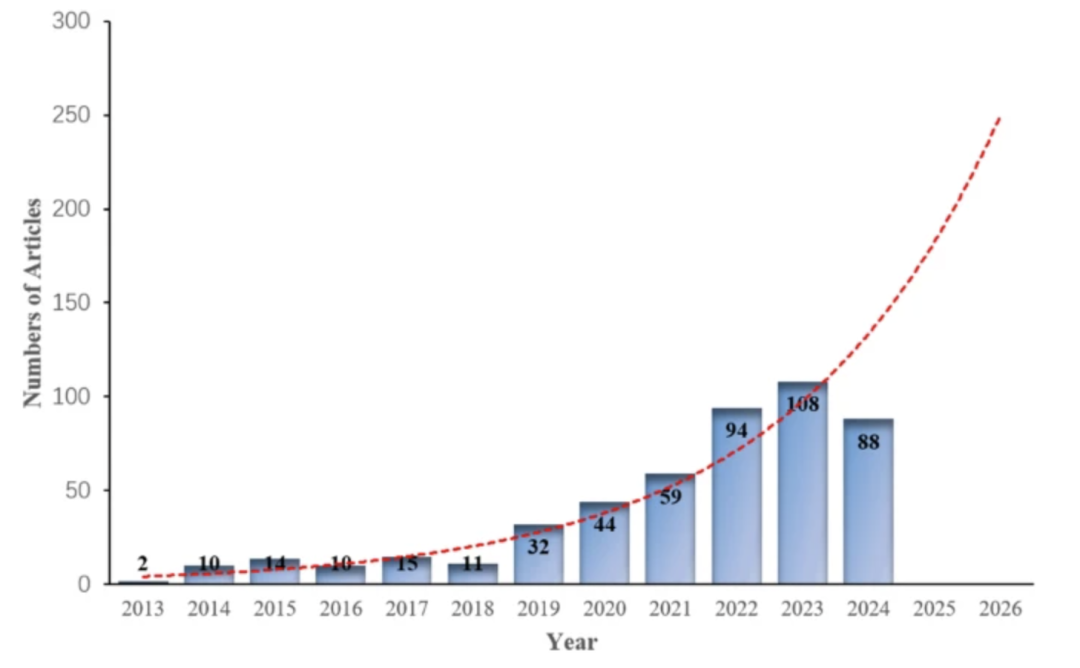
Structural Properties and Chemical Digitalization of MOFs
Currently, the structural properties of MOFs are continuously driving the digitalization of chemistry:MOF's "adjustable metal nodes + organic ligands + topological grid" structure makes it an enumerable and parameterizable discrete chemical space, and a research object that can be understood by material AI.
The reason why MOFs are "ideal candidates for material AI" stems from their inherent modularity and parameterizability. According to the paper "From Data to Discovery: Recent Trends of Machine Learning in Metal–Organic Frameworks" published by the Korea Advanced Institute of Science and Technology in JACS,A MOF basically consists of three separable components, namely metal nodes, organic ligands (Linkers) and spatial topology (Nets).These three correspond to three enumerable discrete variables:
* Different metal clusters/coordination numbers;
* Synthesizable organic ligand chemical skeletons;
* Topologically optional connection method.
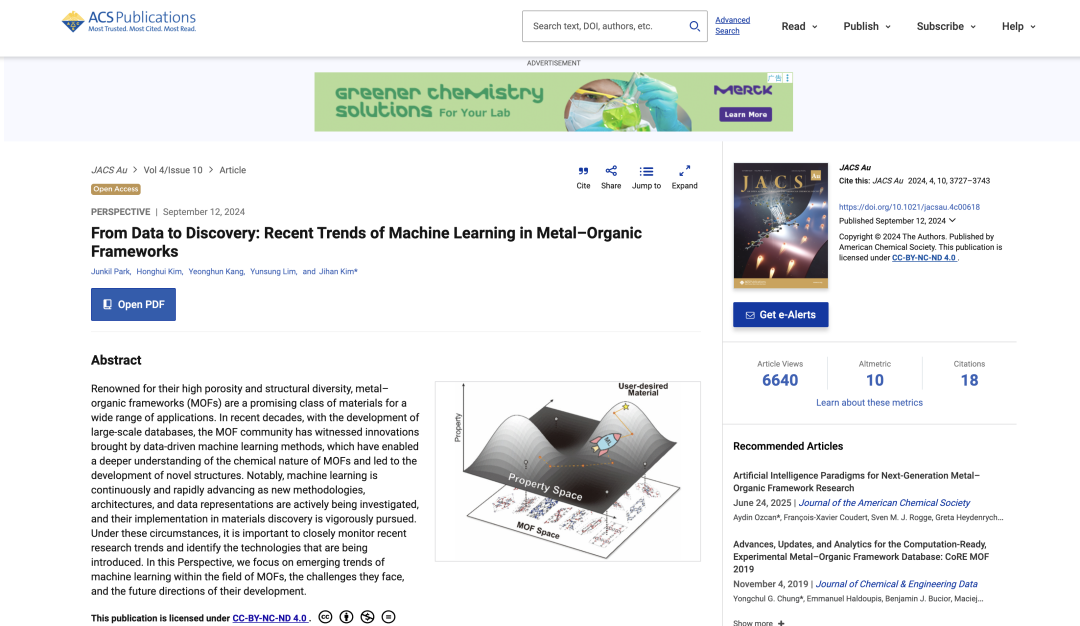
The combination of these dimensions makes the "scalability" of MOF space grow exponentially. At the same time, because the candidate structures have clear chemical semantics,MOFs, as candidate materials, provide "programmable work steps" for digital participation in machine learning.For example, metal clusters can be used as nodes, ligands as edges or hyperedges, and topological information can be encoded as network topology indicators. Graph neural networks (GNNs) can therefore directly learn properties such as adsorption energy and thermal stability from the structure; and scalar descriptions such as cell parameters, pore size distribution, surface area and pore volume can be used as supervised labels or objective functions for multi-objective optimization.
In short, there is no doubt that compared with the situation where chemical structures cannot be enumerated,MOF's modular syntax "discretizes" the chemical space into machine-readable rules, providing an ideal creative paradigm for material AI.It has opened up new paths for the digitalization of chemistry.
Bidirectional symbiosis: AI reshapes MOF research
In a joint paper titled "AI-driven Advances in Metal–organic Frameworks: from Data to Design and Applications," a team from Tianjin University of Technology, the Chinese Academy of Sciences, and the Agency for Science, Technology, and Research (A*STAR) of Singapore stated, "Recent advances in artificial intelligence and machine learning have brought transformative capabilities to the MOF field. Key databases, deep learning architectures, generative models, and hybrid AI simulation frameworks have reshaped high-performance MOF design and screening, enabling accurate property prediction, automated structure generation, and large-scale synthesis planning." In fact, over the past five years, many research teams have indeed achieved phased results in sub-sectors such as property prediction and automated generation of MOF structures based on AI.
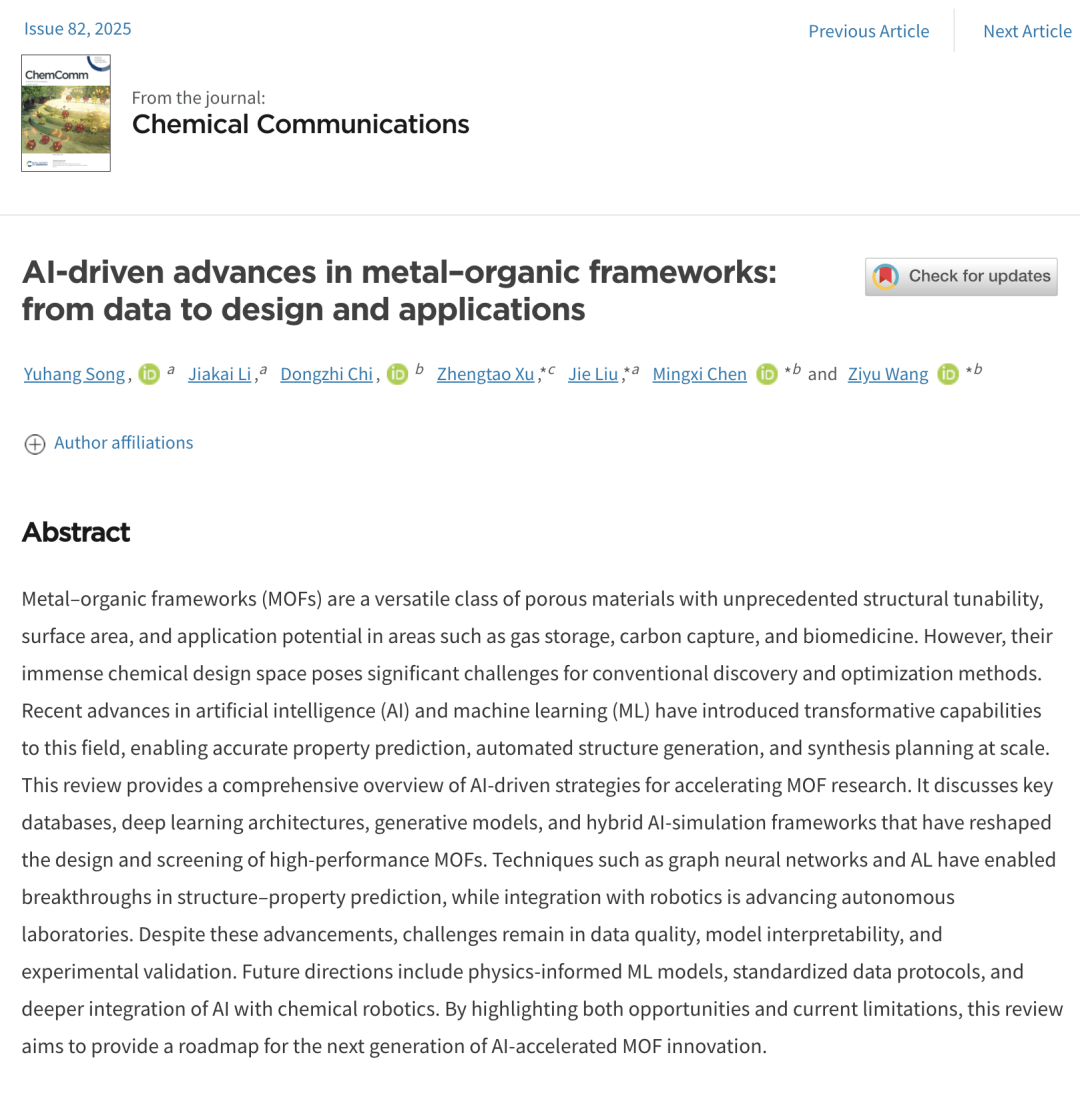
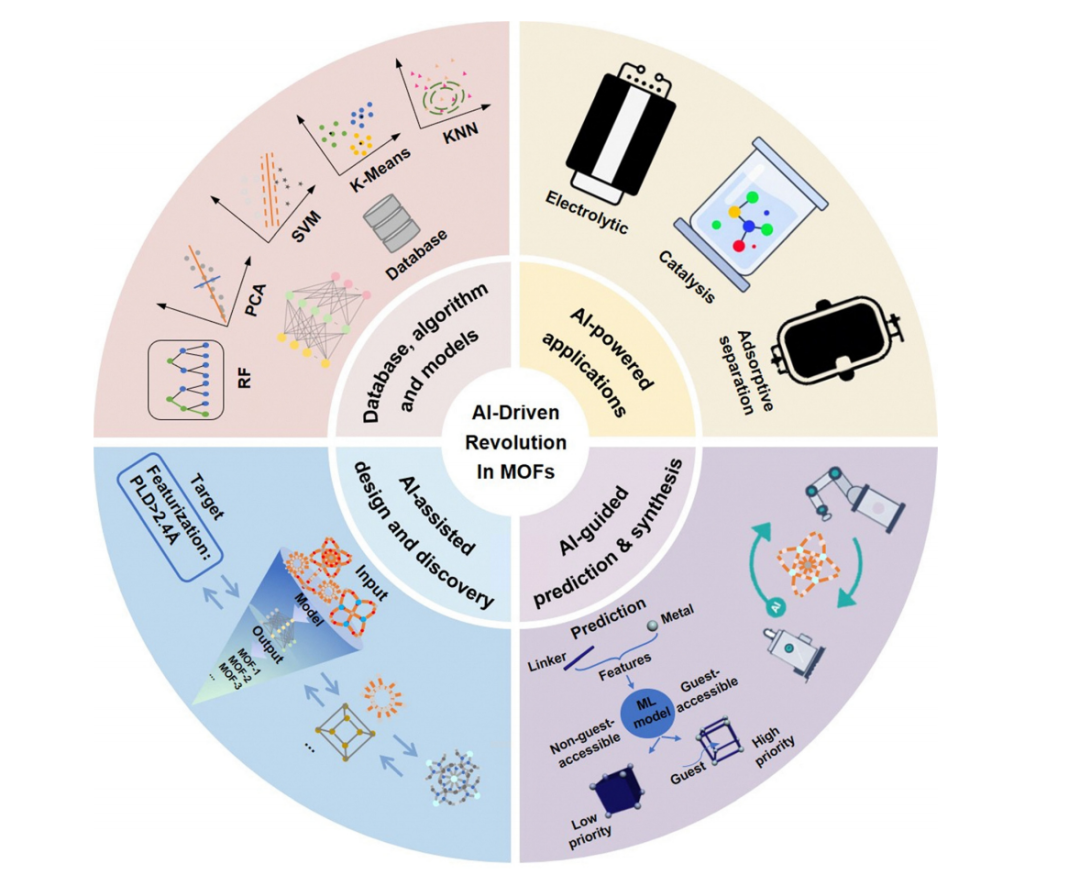
In 2024, a research team from the Korea Advanced Institute of Science and Technology and Pohang University of Science and Technology developed the first deep generative model MOFFlow designed specifically for MOF structure prediction to predict the generation framework of MOF structure.As a continuous regularization process, this framework utilizes the modular characteristics of MOFs and adopts a flow matching method, treating metal nodes and organic ligands as rigid bodies and making predictions in SE space to reduce structural complexity.Its architecture is as follows:
* Split MOF into components such as metal nodes and organic ligands, and define a consistent local coordinate system for them;
* Input the MOFFlow model, set a simple prior distribution as the starting point, define the transformation target from the prior to the target structure distribution, and use the flow matching framework to learn and arrange the random components in a reasonable way;
* Based on the atomic information embedded in the components by the encoder as features, a graph neural network is used to model the geometric and topological relationships between components and predict the rotation, translation and lattice parameters of the components;
* Perform sampling and structural reconstruction; * MOFFlow outputs data, matches and compares the generated structure with the real crystal to verify the validity of the result.

In April 2025, Omar Yaghi and other researchers from the University of California, Berkeley launched the Agentic AI system "MOFGen", which integrates modules such as LLM, diffusion model, quantum mechanics agent, and synthesis feasibility predictor.Used to generate MOF structures from scratch and screen and verify the structures. The MOFGen workflow consists of seven steps:
* The main LLM Agent MOFMaster (Agent 1) provides relevant generation options for the MOF structure and passes instructions to LinkerGen (Agent 2);
* LinkerGen generates MOF chemical formulas based on contextual learning and constraints provided by MOFMaster;
* The formula is fed into the input of the denoised diffusion probability model CrystalGen, which removes irrelevant atoms and moves relevant atoms to possible positions. The crystal structure is generated under the guidance of the formula and without classifier guidance. * Given that the structure generated by the diffusion model deviates from the equilibrium state, the low-level quantum mechanics Agent QForge is used for pre-screening.
* Synthesizability evaluation based on SynthABLE;
* Use QHarden to verify interatomic distances, remove floating atoms, molecular fragments, and other artifacts from the crystal structure, and then perform final optimization of the structure;
* Based on experimental verification by SynthGen.
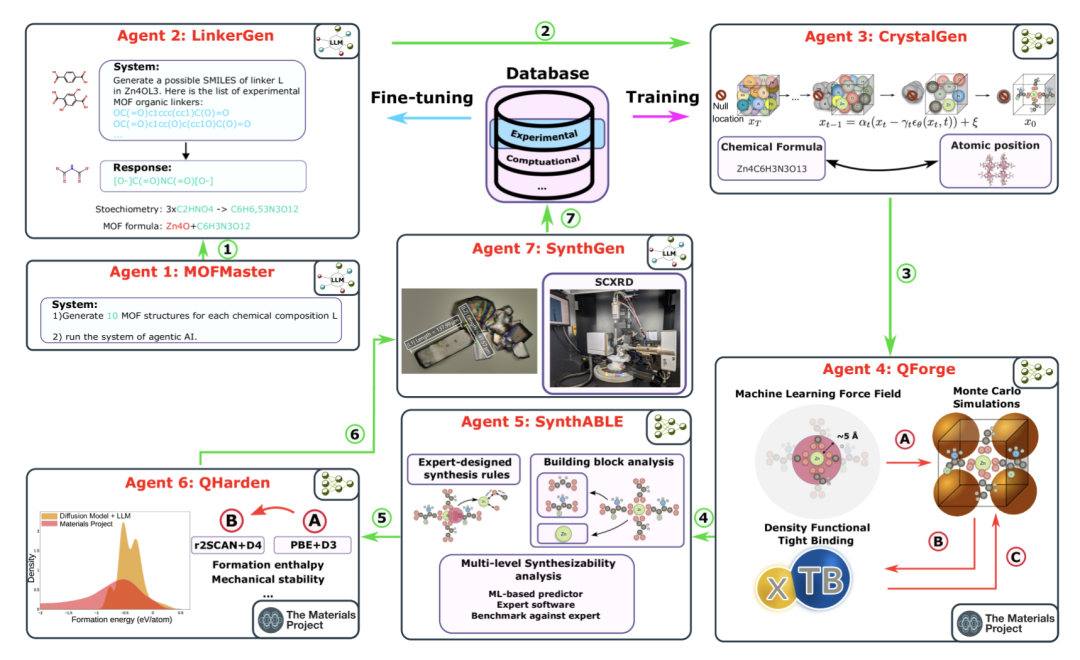
In addition, the existing models are limited to reuse known building blocks and are limited to small unit cells.Research teams from Peking University, Harvard University, Cambridge University and other institutions jointly introduced the SE equivariant diffusion model Building-Block-Aware MOF Diffusion, which can learn the three-dimensional all-atom representation of a single building block and explicitly encode the crystal topological network.
In response to this, the research team proposed a "component-aware" generation approach:
* Using the CoRE-MOF database as a starting point, MOFs are decomposed into three basic units: inorganic nodes, organic ligands, and topological grids;
* Using a diffusion model to simulate the process of structure generation from noise to order, ensuring that each prediction complies with the constraints of chemical bonding and spatial symmetry;
* Component-aware network-based learning identifies the geometric relationships and topological connections between components and learns the underlying chemical laws;
* Sampling from random noise, gradually denoising and restoring the positions of nodes and ligands, and reassembling these components based on the PORMAKE tool to generate a complete MOF three-dimensional structure.
Experiments have shown that by incorporating MOF components into the Diffusion model, BBA MOF Diffusion can generate new MOF structures containing thousands of atomic units, breaking the limitation of "starting from scratch" and providing a practical way to synthesize high-performance MOFs.
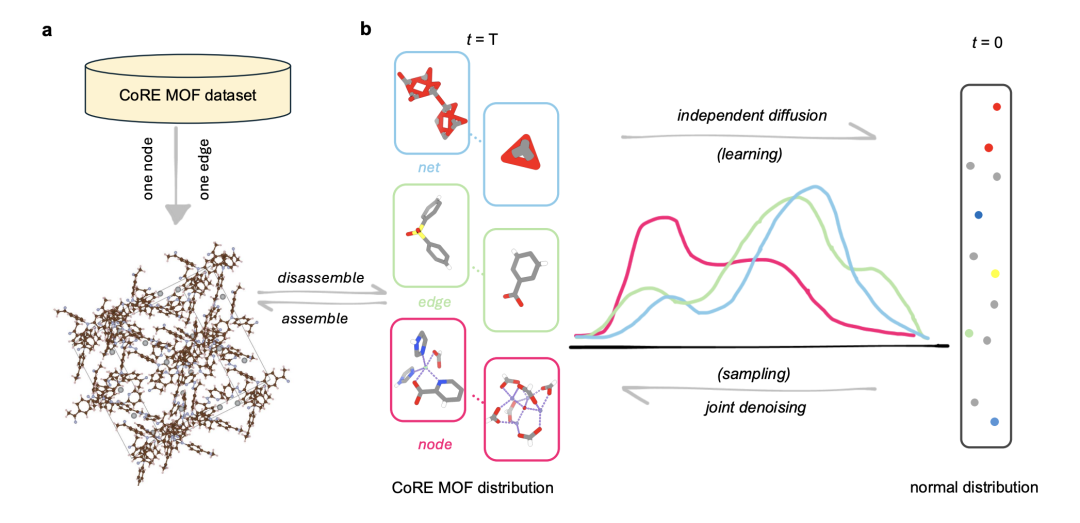
Conclusion
From Robson's prototype of a three-dimensional coordination polymer, to the designable framework established by Yaghi and Kitagawa Susumu, to today's automated generation with AI, the development of MOFs almost mirrors the evolution of chemistry from empirical to computational, and from structure to algorithm. This represents not only a breakthrough in materials science but also a shift in scientific methodology—when molecular design enters a computationally discrete space, chemistry begins to possess its own "language model." In the future, with the convergence of generative AI, quantum computing, and high-throughput experimental platforms, MOF research may further evolve from "empirical discovery" to "data-driven."
Reference Links:
1. https://arxiv.org/html/2504.14110v1
2. https://arxiv.org/abs/2410.17270
3. https://arxiv.org/pdf/2505.08531
4. https://pubs.acs.org/doi/10.1021/jacsau.4c00618
5. https://www.nobelprize.org/prizes/chemistry/2025/popular-information/
6. https://www.nobelprize.org/prizes/chemistry/2025/press-release/
7. https://www.science.org/doi/10.1126/science.abi7281